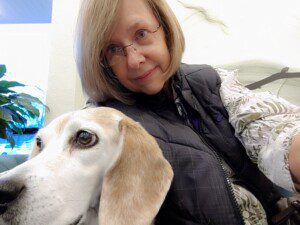 Written by Angie Jones for the RSDSA blog.
Written by Angie Jones for the RSDSA blog.
Four years ago, I was happy, healthy and pain-free. I owned my own business, volunteered in dog rescue, traveled with my family, and enjoyed my life. I had driven three hours to Kansas City and was standing in line when my blood pressure tanked causing me to collapse, spiral downward and was left with an ankle that required reconstruction.
Within days my casted foot had swollen, turned dark purple and felt as if it was on fire. The pain was incredible. Nothing helped. Ice, pain meds, elevation… there was no relief.
Although I shared my concerns with my doctors, they failed to recognize the symptoms of Complex Regional Pain Syndrome (CRPS).
When treated early, many patients go into remission. Sadly, like others, my six-month window had come and gone long before I was diagnosed. I told my cardiologist if he couldn’t tell me what was wrong, I was ready for amputation.
I don’t know what is worse – not knowing what is wrong or being told that you have the most painful disease known to medicine and for which there is no cure.
Eventually, I tried nerve blocks, Lyrica, Gabapentin, Chinese medicine, Calmare, Ketamine infusions, and years of physical therapy. Many of these treatments are not covered by insurance and the benefits, if any, were only temporary.
I had heard about Dr. Katinka van der Merwe and the Neurologic Relief Center in Fayetteville, AR. I decided to reach out for information as I was fearful that my CRPS had spread throughout my body.
I was advised that they do not take insurance and even the best insurance policies refuse to pay for many of the treatments. I knew this was often the case with rare diseases as little is spent on research that will benefit so few. Yes, it terrified me to know I had to withdraw from my IRA when I was on disability. However, what is my future going to be like with a suicide disease?
Anna returned my call and did an excellent job answering my questions. She left me with a sense of hope that I hadn’t felt in a long time.
The first day of treatment, I was overwhelmed by the number of patients in wheelchairs or crutches. I met people from France, Germany, Australia, Sweden, Belgium, etc. The halls were difficult to traverse due to the sheer number of patients and family members.
The staff and fellow patients were incredibly supportive. The patients would spend several hours together each day and then socialize after hours and/or on weekends.
After my first two weeks, I feared I would fail to see improvement and be sent home. As my pain lessened, my worries changed to what happens if I invest all this money and I can’t hold it on my own when I get home. Upon speaking to others, I found these fears to be common.
My physical therapist had warned treatment would be like a roller coaster and she was right. My pain dropped to a point where I was able to quit taking pain medicine but as the weather changed it would spike but never to the point of needing to return to medications.
Eventually, my pain was averaging a mere 1 to 1.5 every day with my foot down and zero elevation, but it took a fellow patient to teach me the importance of trusting the process.
I’d spoken to this woman who’d come in taking each painful step with the aid of a walker on her first day. Within a couple of weeks, she was wearing a Fitbit, counting her steps and walking swiftly without pain. I told her she was looking great and she told me her neurologist didn’t need to see her anymore because she is doing so well. More importantly, she told me that she was no longer planning her farewell party.
Dr. K and her staff are amazing. I witnessed miracles as many patients left in remission and others like me were very, very close.
Am I done? Not yet, but I feel as if I have a future again. I literally experienced the most progress the last two days of my treatment. If I would have had another week or two, I believe that I would be in complete remission. I know that I can and will win this battle with CRPS and so can you.
This blog is not intended to provide advice on personal medical matters or to substitute for consultation with a physician.
Please consider making a donation to RSDSA today!
